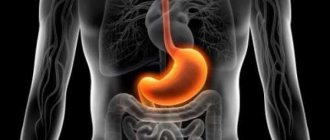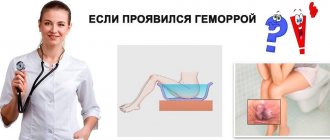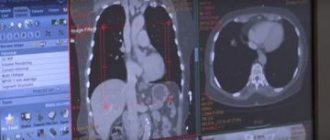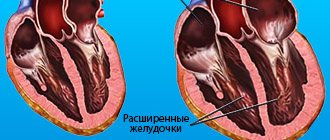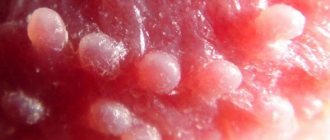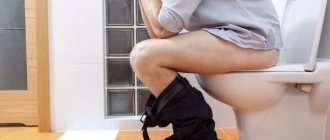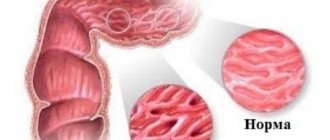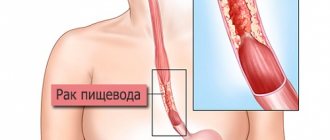Clinical manifestations of pathology
With anal fissure, the symptoms of the disease differ in very specific manifestations. There are 3 main signs, which include the occurrence of severe pain in the rectal area, bleeding and anal spasms.
Cracks in the anus very often appear in parallel with the development of varicose veins of the pelvic organs. Therefore, prolapse of hemorrhoids may additionally be present.
Anal fissure can be acute or chronic. This determines the clinical symptoms of the disease.
An acute fissure is characterized by the appearance of sharp pain in the anus. As a rule, this occurs at the end of a bowel movement. The discomfort disappears quite quickly. Symptoms of an anal fissure include spasm of the rectal sphincter, which manifests itself as difficulty in the free passage of feces. A rather specific sign is the appearance of fresh blood, especially with constipation, when damage to the walls of the defect occurs during the passage of hard feces.
Chronic anal fissure has similar symptoms. The pain is characterized by less intensity and appears periodically. However, the unpleasant sensations persist for quite a long time after defecation, which provides severe discomfort while moving and performing any work. A person tries to prevent constipation from occurring, as this threatens to worsen the disease. Against this background, the patient begins to uncontrollably use various laxatives, long-term use of which can disrupt the normal balance of intestinal microflora.
Causes of the disease
An anal fissure is a defect in the mucous membrane of the anterior or posterior walls of the rectum.
It is a small vertical tear (up to 2 cm long), the bottom of which reaches the muscle layer. Women of reproductive age are more often affected. The formation of rectal fissures is due to many reasons:
- injury to the mucous membrane from solid feces due to constipation;
- congestion in the pelvis due to lack of physical activity;
- inflammatory bowel diseases caused by pathological microflora;
- increased pressure on the rectum when lifting weights;
- strong efforts during childbirth in women;
- mechanical injuries of the anus.
Rectal fissure can be acute or chronic. The first wound that appears is treated in 3-4 weeks using non-surgical methods. If complete healing does not occur during this period, the disease becomes recurrent and requires surgical intervention.
Principles of therapy
How to cure a fissure in the anus?
If unpleasant symptoms occur that indicate a violation of the integrity of the rectal mucosa, you should immediately consult a doctor. This will prevent the progression of the pathology and transition to the chronic stage. It is not recommended to try to get rid of the problem on your own, since the treatment of anal fissure must be comprehensive. Only a specialist can develop the necessary therapeutic regimen with which you can get rid of the pathology.
Rectal suppositories are most often used to treat the disease. Thanks to local application, the medicine acts directly on the defect in the rectal mucosa, promoting its speedy healing and restoration of integrity. In complex therapy, ointments are necessarily used, especially when the fissure is localized in the anus.
The use of alternative medicine methods shows good results. However, their use must be agreed upon with a specialist.
How to cure anal fissure? To achieve a quick recovery, you need to follow your doctor's recommendations. Even if you feel better and clinical symptoms weaken, therapy should not be interrupted under any circumstances. This threatens the rapid development of relapse.
Modern techniques in the treatment of anal fissure
An anal fissure (or anal fissure or fissure) is a spontaneously occurring linear or damage to the mucous membrane of the anal canal of the rectum and is one of the most common proctological diseases. There are acute and chronic stages of the disease.
Acute anal fissure, if left untreated after the first episode of pain for more than three months, usually becomes chronic. With a chronic anal fissure, the mucous membrane thickens at the edges, external (skin) and internal (fibrous polyp of the anal canal) sentinel tubercles are formed and drug treatment is no longer sufficient.
Causes of anal fissure
- insufficient intake, fatty carbohydrate-rich foods, spicy foods and alcohol abuse
- constipation or diarrhea
- pregnancy and childbirth
- practicing certain sports (cycling)
- mechanical damage to the rectal mucosa (including during anal sex)
- acute hemorrhoids, cryptitis and other proctological diseases
- hard physical labor
Crack: symptoms and signs
- pain in the anus during and after bowel movements
- bleeding during bowel movements in the form of marks on stool and toilet paper
- spasm of the internal sphincter
- feeling of discomfort, itching, burning in the anal area
note
Symptoms such as pain and blood during bowel movements may also indicate the presence of an oncological process. Therefore, do not self-medicate, but consult a doctor in time. With inadequate treatment of an anal fissure, complications may develop such as paraproctitis - acute or chronic inflammation of the tissue. Paraproctitis is one of the most common proctological diseases (20-40% of all rectal diseases). By starting treatment in our center in a timely manner, you can use minimally invasive conservative methods without pain and discomfort.
How is anal fissure treated at GRAND MEDICA?
To diagnose hemorrhoids at the initial consultation, the coloproctologist performs a visual examination, digital examination, anoscopy and, if indicated, sigmoidoscopy (painless instrumental examinations). An anal fissure is a tear in the skin around the anus. This is a common problem that can cause severe pain, especially after bowel movements. This condition is associated with spasm of the internal anal sphincter. The spasm reduces blood flow to the damaged area and interferes with healing. The goal of treatment is to break this pathological cycle and speed up healing.
Conservative treatment
Surgery is effective for treating anal fissures, but it is usually reserved for patients who have failed non-surgical treatments. Alternatives to surgery include laxatives, ointments, botulinum toxin injections, eating a high-fiber diet, and drinking more water. The primary treatment for anal fissures is to use ointments to relax the anal sphincter and reduce pain, thereby promoting healing. However, for some people the use of ointments is inconvenient and embarrassing, and some patients develop headaches that are sometimes so severe that this is a reason to stop treatment with ointments.
Chemical sphincterotomy (botulinum toxin injection)
Injecting botulinum toxin into the anal sphincter muscle relaxes the muscle sufficiently to prevent spasm and pain and leads to healing of the fissure. This procedure is performed under topical anesthesia, as part of outpatient care. The main advantage of using botulinum toxin injection is the ability to avoid lateral sphincterotomy (dissection of the sphincter), in which part of the lateral fibers of the sphincter muscle is dissected; This procedure has a very low risk of permanent incontinence. Most patients feel better after receiving a botulinum toxin injection. Very rarely, but some patients require a second injection of botulinum toxin after 2-3 months.
Lateral sphincterotomy
Sphincterotomy means cutting the sphincter. The operation is performed under general anesthesia. The doctor will make a small incision in the skin near the anus. He will then cut the lower part of the internal sphincter muscle. This will ease the spasm and improve blood circulation to heal the fissure. Cutting the sphincter creates a permanent effect, and one of the risks of this procedure is weakening the strength of the muscle. This is why some patients develop loss of control, which manifests as gas incontinence or stool leakage.
Crack excision
Indications:
- There is a high risk of developing anal incontinence after sphincterotomy;
- Perineal ruptures during childbirth in women;
- Clinical signs of pelvic floor prolapse;
- Age over 60 years;
- The presence of a prolapsing internal sentinel tubercle;
Using an electrocoagulator, an incision is made in the mucous membrane and skin around the crack. Then, flatly, along the projection of the sphincter muscle fibers, a fissure with a crypt, sentinel tubercle and hypertrophied anal papilla is excised within healthy tissue. Excision is performed in the form of a triangle, with its apex facing the intestine, the base facing the perianal skin, or in the form of an ellipse.
After discharge from hospital
For the fastest healing, you should stay in bed for the first few days and walk as little as possible. The wound may take several weeks to heal, so you will need to wear a pad. Regular exercise will help you return to your usual activities faster. You need to ask your doctors what exercises to do and when to start doing them. Recovery after surgery is very individual. Some people experience severe pain and swelling, while others have minimal discomfort. Consult about painkillers and laxatives to prevent constipation.
Any pain caused by the crack should go away quickly. Return to work usually occurs within a few days, depending on your line of work.
If, unfortunately, you experience severe abdominal pain or heavy bleeding, please contact the clinic or emergency room immediately, making sure to notify them that you have had surgery.
In the postoperative period until the wounds heal, patients are required to perform regular sanitation of the anal area using sitz baths with a weak solution of potassium permanganate or chamomile. Perform daily dressings using ointment bases (which our specialist will individually select for you), which have an anti-inflammatory and wound-healing effect.
Weekly medical monitoring of the course of the wound process is necessary until the wounds are completely healed. During the period of wound healing, a diet rich in plant fiber and dietary fiber intake (as an option, psyllium seed preparations) are required to soften the stool.
Diet No. 3 according to M. I. Pevzner
Cooking technology: food is prepared mainly unchopped, boiled in water or steamed, baked. Vegetables and fruits are consumed both raw and boiled. Food should mainly consist of vegetables, fresh and dried fruits, baked goods, cereals, and fermented milk drinks.
Allowed:
- Bread – wheat bread made from wholemeal flour: “Doctorsky”, “Zdorovye”, crispbread (soaked), rye. The cookies are dry, unpalatable pastries.
- Soups - mainly from vegetables in meat broth, cold fruit and vegetable soups, borscht, beetroot soup, cabbage soup made from fresh cabbage.
- Meat and poultry – lean varieties of various types of meat, chicken, turkey, boiled or baked, in pieces or chopped. Milk sausages.
- Fish – low-fat types, boiled or baked; seafood dishes.
- Vegetable dishes and side dishes - various types of vegetables and herbs, non-acidic sauerkraut, beets are especially recommended. Dishes and side dishes made from flour, cereals, legumes, crumbly and semi-viscous porridges, puddings, casseroles. Pasta, boiled and in the form of casseroles, dishes made with buckwheat are especially recommended. Legumes: green peas, bean curd.
- Eggs – no more than one egg per day, it is better to add them to dishes.
- Fruits, berries, sweet dishes and sugary products - melons, plums, figs, apricots, prunes, sugar, jam, especially rowan, honey, compotes (especially rhubarb), mousses, fruit candies are especially recommended.
- Milk, dairy products and dishes made from them - milk (if tolerated - sweet), sour cream, cottage cheese, yogurt, one- and two-day kefir, acidophilus milk, cheeses.
- Sauces and spices - milk, sour cream with vegetable broth, fruit and berry sauces.
- Fats – butter, vegetable oils from dishes.
- Appetizers - raw vegetable salads, vinaigrettes with vegetable oil, vegetable caviar, fruit salads, mild cheese, low-fat ham, soaked herring, jellied meat and fish.
- Drinks - tea, coffee substitutes, rosehip and wheat bran decoction, fruit and vegetable juices (plums, apricots, carrots, tomatoes).
Prohibited:
Bread made from premium flour, puff pastry and pastry, fatty meats and fish, duck, goose, smoked meat and fish, canned fish and meat, (limit rice and semolina), radish, radish, garlic, onion, turnip, mushrooms, jelly, blueberries, quince, dogwood, chocolate products with cream, hot and fatty sauces, horseradish, mustard, pepper, cocoa, black coffee, strong tea, animal and cooking fats, alcoholic beverages.
The clinic's coloproctology service has the most modern equipment and technologies for diagnosing and treating a wide range of diseases of the colon and rectum.
Make an appointment with a proctologist by phone or leave a request on the website.
The use of rectal suppositories
How to treat anal fissures? The necessary medicine must be prescribed by a doctor based on the results of examination and examination of the patient. It is advisable to use suppositories after defecation, so that the drug has an effect directly on the pathological focus, and the active substance does not mix with the feces. To cleanse the intestines, you can do a cleansing enema. This will ensure maximum therapeutic effect from the use of rectal suppositories.
Basic remedies for treating anal fissure without surgery:
- Natalsid candles. They have a pronounced wound-healing and regenerating effect due to the properties of the main component – sodium alganite. The product is made on the basis of brown algae and is natural. Thanks to this, it is approved for use during pregnancy and breastfeeding, since it has no contraindications for use.
- Posterized. It contains inactivated microbial cells and the hormonal component Hydrocortisone. Suppositories have a pronounced anti-inflammatory and analgesic effect, relieve itching and promote healing of damage. The presence of microbial cells provides increased local immunity.
- Ultraproct. Promotes rapid improvement of the patient's well-being, since the composition contains a glucocorticosteroid, which has an antipruritic, analgesic, regenerating and anti-inflammatory effect. These suppositories are used to treat not only cracks, but also hemorrhoids.
- Relief. The composition includes a natural component – shark liver. Helps improve local immunity, has a hemostatic effect, and relieves inflammation in the area of the defect.
- Sea buckthorn candles. Provide rapid healing and restoration of the integrity of the rectal mucosa. They have an antimicrobial effect and prevent infection of the fissure by pathogenic microflora, which is very often present in the large intestine.
Use of rectal medications
When you start taking rectal suppositories, you should adhere to the above rules. If you do not have much experience in how to place a suppository correctly, then many proctologists recommend holding the medicine at the anus for such people. In this case, the time of such a delay should be 4-6 minutes. This will allow the patient to enhance the effectiveness of the drug and not have to think about whether it went where it was supposed to.
When selecting the required suppositories for the treatment of hemorrhoids, you cannot self-medicate, since the composition of the selected medicine may contain elements that are contraindicated for a sick person to take. The choice of means to treat the disease should be made only by qualified specialists. In addition, doctors prescribe a course of therapy only after the patient's test results are received.
During such analytical studies, doctors determine the stage of the disease and the main symptoms of its manifestation. This also makes it possible to understand how badly the hemorrhoids are damaged and the areas where they are located. In addition, with the help of diagnostics it is possible to understand whether a person suffers from internal or external hemorrhoids.
https://youtu.be/6klkdeNOZec
All rectal medications are used several times during the day (2-5 times). Therefore, if hemorrhoids are in an advanced form, then they need to be treated only in a hospital or at home. This is due not only to the need for medical supervision, but also to the inconvenience of using rectal suppositories in public places.
Application of ointments
How to treat an anal fissure in an adult if it is located in the anus? To treat the defect, it is advisable to use an ointment that has not only anti-inflammatory, but also regenerating properties. The medicine should be applied to the site of injury after defecation and hygiene procedures. The ointment should be used not only externally, but also on the anal sphincter. To do this, you need to apply the medicine to a cotton swab and insert it into the anus to a depth of about 1 cm.
Symptoms and treatment of the disease are interconnected. Based on the clinical picture and complaints of the patient, the doctor decides on the need to prescribe certain medications.
For the treatment of anal fissures, the following drugs are mainly used:
- Aurobin ointment. A combined drug that contains the glucocorticosteroid Prednisolone, the anesthetic Lidocaine and Dexpanthenol. This causes analgesic, anti-inflammatory, antipruritic, regenerating and restorative effects.
- Cream Bepanten, Pantesol, Dexpanthenol. Used to quickly restore the integrity of the skin and mucous membranes.
- Solcoseryl. Provides the necessary nutrition to tissues, resulting in rapid healing of the wound.
- Methyluracil ointment. Reduces the severity of the inflammatory process and has an immunostimulating effect.
- Emla. A strong pain reliever that contains lidocaine and prilocaine. It is used for severe spasm of the rectal sphincter and the patient’s obvious fear of defecation. At the same time, the ointment has a large number of contraindications for use.
https://youtu.be/dwP8k6Ylw6U
Indications and contraindications
Like other medications, suppositories must be prescribed by a doctor. For the treatment of hemorrhoids and anal fissures, he selects medications based on the patient’s condition, symptoms of the disease, and the presence or absence of other chronic ailments. Rectal suppositories for anal fissures are recommended for:
- Chronic constipation.
- Internal and external bleeding.
- Damage to the skin and mucous membranes.
- Pain, itching and burning.
- Inflammatory processes.
- Purulent fistulas.
- Erosion of the anus.
The drugs are used in courses, they are inserted 2-3 times a day after thorough cleansing of the anorectal area. Treatment tactics continue for 7-10 days, some suppositories can be used for a long time (up to 3 weeks).
Rectal suppositories are easy to use, treatment with them combines well with other drugs, and is suitable for various manifestations of the disease. A variety of drugs allows you to choose an option for any symptoms. Suppositories have a mild laxative effect and help improve bowel movements, which is very important for chronic and acute hemorrhoids.
Despite their wide range of uses, suppositories also have contraindications. They are not recommended for:
- Autoimmune diseases.
- Diabetes mellitus and severe tuberculosis.
- Heavy internal bleeding.
- Hemophilia and other chronic blood diseases.
- Tendency to diarrhea.
Before starting treatment, you should consult with an experienced coloproctologist. He will recommend the best suppositories, suggest the optimal course and select accompanying medications that can speed up recovery.
Traditional methods of treating the disease
How to treat anal fissure using alternative medicine? For this purpose, you can use the healing properties of medicinal plants and some vegetables.
Propolis candles
Good results in treating the disease are shown by candles made independently from propolis. The beekeeping product has unique anti-inflammatory, antiseptic, regenerating and restorative properties. To prepare a suppository, you need to place a small amount of propolis in the freezer, and after completely freezing, grind it using a coffee grinder. Pour the mixture with cold water in a ratio of 1:10 and mix well. Place the product in special molds for making candles or form them yourself and wrap them in parchment paper. Place the finished medicine back in the refrigerator to harden. Before use, the candle should be immersed in warm water for a few seconds to avoid discomfort when the medicine is administered into the rectum. The duration of such therapy is at least 7-10 days.
Beetroot can be used to treat anal fissure. A small piece should be cut out of the vegetable, resembling a standard suppository in shape. Its length should not exceed 5 cm, and its width should not exceed 1.5 cm. Inject the product into the rectum at night, and in the morning it will come out on its own during bowel movements. After this, you need to carry out hygiene procedures and lubricate the anus area with sea buckthorn oil.
To speed up recovery in complex treatment, you can use sitz baths based on decoctions of medicinal herbs. The collection, which includes chamomile, nettle, plantain and oak, has anti-inflammatory, wound-healing, regenerating and analgesic effects. All components must be mixed in proportions 1:1:3:2, take 2 tbsp. l. mixture and pour 1 liter of boiling water. Leave the mixture for 10-15 minutes, strain and cool slightly. Pour the solution into a basin or other suitable container and use it for sitz baths. It is necessary to ensure that the temperature of the liquid is not too high to prevent skin burns. This type of therapy lasts 7-10 sessions.
Treatment of anal fissure at home should be carried out under the supervision of a specialist. If there is no positive result, you should consult your doctor again to adjust your prescription.
Nutrition rules
Successful treatment at home is impossible without following a diet. Its goal is to combat constipation and stimulate the immune system. The diet should contain easily digestible foods rich in vitamins and other beneficial substances:
- lean meat (rabbit, poultry, veal);
- lactic acid products;
- vegetables, fruits, garden herbs;
- whole grain porridge, bran bread;
- sea fish and seafood.
Prunes, boiled carrots and beets, and dried fruit compotes have a laxative effect. You need to drink a lot of water - at least 1.5-2 liters daily.
Strong coffee and tea, carbonated drinks, smoked foods, and fast food (convenience foods, fast food) are prohibited. You need to eat food 4-5 times a day, in small portions.
How to use suppositories for hemorrhoids
How to properly place suppositories for hemorrhoids - let's look at them point by point.
Preparation for the procedure
Before administering suppositories, you need to prepare.
If normal bowel movements are impossible, you should do a cleansing enema with warm water. Then the anus area is washed with water and baby soap and dried with a terry towel or gauze cloth. Particular care must be taken when cleansing skin that has damage: abrasions, rashes, anal fissures. Before administration, you should not use ointments, gels and other external agents. If you plan to administer suppositories 3-4 times a day, there is no need to cleanse the intestines
It is enough to wash with warm water and dry the skin.
If you plan to administer suppositories 3-4 times a day, there is no need to cleanse the intestines. It is enough to wash with warm water and dry the skin.
Candles are removed from the packaging immediately before use. You cannot open the package in advance; the suppositories may dry out or become dirty.
It is not recommended to hold the candle in your hands for a long time; under the influence of heat, solid fats begin to melt, which makes insertion difficult.
Introduction of suppositories: how to do it correctly
It is more convenient to insert the suppository in a lying position on the right side. For those for whom this position is not suitable, you can try inserting the candle while standing, slightly leaning forward or crouching.
It is important that the anus muscles are completely relaxed and the anus is as open as possible. If the candle seems too dry or hard, its tip can be lubricated with petroleum jelly or glycerin. Use your hand to spread the buttocks and, with light force, push the candle into the anus
The suppository should completely pass the sphincter without causing discomfort.
Use your hand to spread the buttocks and, with light force, push the candle into the anus. The suppository should completely pass the sphincter without causing discomfort.
After administration, you need to close your legs and lie down for at least 20 minutes.
If there is a urge to defecate, you need to endure it. Most often, these urges are a common reaction to a foreign body in the rectum. The discomfort will go away in a few minutes.
It is best to administer suppositories before bedtime. The drugs will relieve pain and other unpleasant symptoms, allowing you to sleep peacefully. In 7-8 hours, all active components will be absorbed to the maximum extent, and in the morning the patient will feel much better.
After inserting the suppository, the anus area is covered with a sterile gauze pad. You can use sanitary pads or a bandage folded in several layers. This design is needed to protect underwear and bed linen.
Under the influence of body temperature, the paraffin, wax, and petroleum jelly contained in the suppositories will melt and naturally leave the body. A small amount of fatty components can also be found in feces, you should not be afraid of this. Solid fats included in suppositories are not absorbed by the body.
Check out some other topical treatments for hemorrhoids:
- in the form of ointments: heparin, Bepanten, methyluracil, ichthyol, zinc, Aurobin, Bezornil;
- and gel: Hepatrombin, Troxerutin, Lyoton.
Rectal suppositories are indicated for various forms of hemorrhoids; they act quickly, are easily digestible and have a minimum of contraindications. Now you know how to use suppositories for hemorrhoids. Treatment is best carried out under the supervision of a doctor, this will help avoid side effects and complications.
Brief summary
From this article you learned about what an anal fissure is and in what cases it can occur. It is worth making a reservation that during exacerbation of the disease, research manipulations are not allowed. The pathology must first be cured. If you have such a delicate problem, don't wait. Please note that within a month, your inaction can transform the pathology into a chronic, more complex form. In this situation, all the doctor’s efforts to cure you with medications may be powerless. Take care of your health and don’t get sick!
